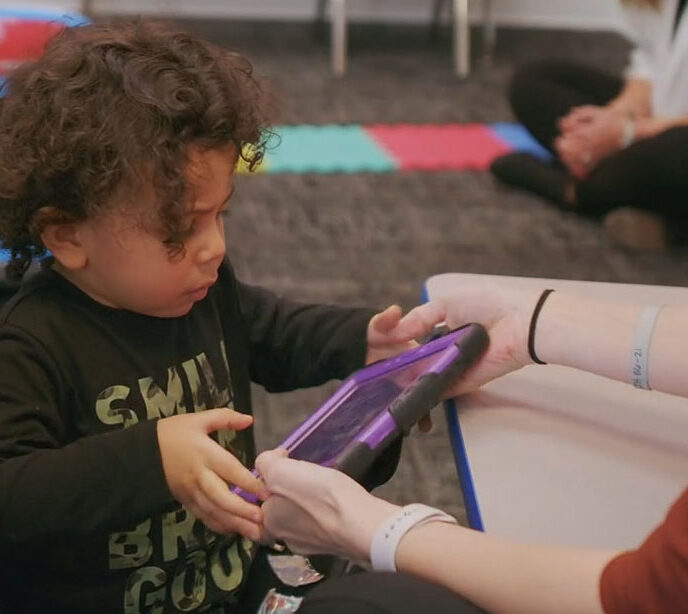Elopement – Prevention & Safety
A Guide to Elopement in Autism – Causes, Prevention & Safety
Elopement presents a major risk to your autistic child’s safety. Find out the causes of elopement, what prevention strategies to use, as well as how to plan for possible elopement.

Autism Elopement Prevention & Safety
When most of us think of the word “elope” we picture two people sneaking off to get married, often on a whim, without the traditional ceremony. However, in terms of autism care, elopement has a different meaning. In the context of autism and special education, elopement is when someone, often a child, who may require supervision, leaves a designated safe area or a responsible caregiver without permission or supervision. This can happen in schools, therapy centers, or even at home, and the consequences can be severe. While therapy centers and schools catering to autistic children will have stringent measures in place to prevent and deal with elopement, it’s important for parents and caregivers to understand the seriousness of preventative measures at home.
Why Knowing How To Deal with Elopement is Critical in Autism Care
Every parent’s main goal is keeping their child safe. But, when your child has been diagnosed with a developmental condition like autism, this goal can come with extra challenges. Wandering, or elopement, is one of these challenges. Autistic children are roughly four times more likely to leave a safe environment without permission than their allistic siblings. And, unfortunately, autistic children who elope often fall victim to harm through traffic accidents, drowning, falling, extreme weather, or even encounters with predators (human or otherwise).
Nearly 50% of autistic children have eloped at some point in their lives, often with tragic consequences, and many parents are left in a constant state of anxiety. When faced with such a terrifying prospect, it is no wonder that parents of autistic children can be tempted to employ extreme measures to protect their children without considering whether their interventions will be effective or not.
According to the Organization for Autism Research (OAR), following their Safety Planning Cycle helps parents to constantly equip themselves and their children with the tools and skills to secure their child’s safety through prevention and planning.
Why Do Autistic Children Elope?
Firstly, it is important to understand why many autistic children elope. Autistic individuals tend to elope or wander due to factors like sensory overload, curiosity, or a desire to escape an uncomfortable situation. In their review of the assessment and treatment of elopement, Dr. Megan Boyle and Dr. Reesha Adamson of Missouri State University describe the four most common reasons for elopement as follows:
- To get away from a place, activity, or person (escape)
- To obtain access to an item, activity, or person
- To engage in an intrinsically pleasurable activity, such as running
- To gain attention
Understanding your child’s triggers makes prevention and safety much easier to manage. If it is not immediately apparent why your child elopes, consider keeping a log of every elopement, to help you identify trends.
Here are a few questions to guide what to log:
- What sequence of events preceded the elopement?
- Who was present?
- Can you remember any significant stimuli or obvious triggers?
- Where was your child going?
- What happened after the elopement?
Once there is a fair understanding of the reason for elopement, parents need to develop an elopement prevention plan that anticipates these triggers and mitigates the need for elopement as a response.
The elopement precaution and prevention plan may include some of the following interventions.
The Safety Planning Cycle
There are five basic steps in the Safety Planning Cycle:
1. Understand
What does your child need? What makes the child safe or unsafe in a particular situation? Where possible, engaging your child in the process can help you get valuable insights into their perspective and give them a sense of control and empowerment to be a part of their own safety plan.
2. Prepare
What skills does your child need to practice in order to be safe? What resources do they need? What can be done to support your child? Parents might consider tools like GPS trackers for added security, visual schedules for predictability, or wearable ID tags for emergencies. We go into more detail on these measures later in the blog.
3. Practice
Once you’ve created your plan and identified the various tools and skills, implement them and find effective ways to reinforce them. For example, you can practice scenarios that mirror real-life situations, like safely crossing a busy street or responding to a change in routine.
4. Share
This is a key step towards securing your wandering child. Share your plan, skills, and tools with everyone entrusted with your child’s safety as well as those who form part of your support network. From school teachers to community safety personnel like police, firefighters, and EMS, the more people who are aware of your needs, the safer your child is.
5. Update
Work with your child to constantly assess the plan, tools, and skills. See what works and what doesn’t then revise and update the plan accordingly. As your child grows and gains new abilities or faces new environments, revisiting milestones and adapting the plan is crucial to keep it effective.
Behavior Modification
Elopement prevention for autistic children should go beyond ensuring a safe environment for your child. Remember that children who feel safe, who feel that they have a choice in their decisions, and who feel that all their physical and emotional needs are met, are far less likely to elope.
So, to create a safe home for your autistic child, yYour prevention plan should therefore begin with behavioral interventions that reduce the need for your child to elope. These should also be supplemented with more practical interventions to inhibit them should they be overcome with the urge to run. ABA interventions for elopement are particularly effective, as they focus on understanding the functions of behavior and teaching alternative, safer responses to meet those needs.
A behavior intervention plan for preventing elopement should focus on addressing the triggers mentioned above. A key tool in this is to implement Functional Communication Training (FCT), a process of reinforcing alternative behaviors to elopement that meet the needs of the child as defined by the triggers. Here are a few FCT interventions that you can discuss with your professional support network to consider in your plan.
Attention-Seeking
When it comes to autism and elopement, particularly in cases of a child seeking attention, parents should use visual aids to teach the child how to get their attention without running away. Parents, who are often the preferred person, should be the ones using visual aids to reinforce the alternative behavior. It might also help to give increased fun and exciting attention in spaces where you want your child to stay.
Parents should avoid overly angry responses to elopement as this will reinforce the need for attention. Instead, provide positive reinforcement for all things you want your child to do, other than elopement.
Trying To Escape
First, try to identify what would trigger a child’s need to escape a particular situation. This could be overstimulation, change in environment, or even just a chaotic or noisy environment.
Parents need to teach their children how to ask for a break from whatever the trigger is rather than elope. If they run anyway, it is important to bring them back safely and then review better strategies for escape in the future.
Once back, parents should adjust the task or change the environment to reduce the stress on the child by introducing breaks or moving to a quieter room. This should then be followed by positive reinforcement of getting back to the task. Again, meeting elopement with anger will trigger further elopement or in this circumstance, turn it into a game.
Doing Something Pleasurable
Sometimes referred to as “automatic reinforcement or maintained behavior,” autistic children often elope simply to engage in something they enjoy doing, like running or feeling the breeze outside.
In cases where automatic reinforcement is the trigger, parents need to provide more regular access to that activity in a controlled environment. This will reduce the impulse to elope to access it. For example, a child who loves running should have additional access to a gym or track with supervision.
Desire to Access an Item, Person, Area, or Activity
Where the trigger is a desire to gain access to an item, person, area, or activity, parents need to teach their children how to ask for it or access it in a safer way. It is also important to establish a routine for access. Explain when they will get access and reinforce this by making absolutely sure that they get it on schedule. A break in routine will definitely encourage elopement.
Teach Your Child Essential Skills
Here are some situational elopement strategies to prevent autistic children from wandering off, as well as ways to protect them should they succeed.
Swimming
Swimming lessons for children with special needs can be difficult to find. The YMCA in many locations across the country offers this specialized service at affordable rates.
How To Navigate Traffic
Teach your child basic traffic navigation skills like what traffic lights mean, when and where to cross the road, and how to avoid moving vehicles.
Stay With You in Public Spaces
Teach your child to understand the difference between walking and running. Reinforce holding hands or to walk within 6-12 inches of an accompanying adult as well as words like “go, walk, stop”. Reinforce things like staying by the cart in a grocery store, or keeping a hand on the cart in a parking lot.
How To Communicate Contact Information
Verbal children can be taught to memorize parents’ phone numbers, addresses, and other critical information and should be taught how to provide the answers. This may be difficult or impossible for non-verbal children, so alternative means may be necessary in the form of an ID bracelet or card. Even in verbal children, this is a useful tool.
Practical Interventions
Behavioral interventions will only go so far toward mitigating the underlying reasons for elopement. Skills are usually employed once in distress. There is even a risk of elopement in autistic children with low-support needs, which requires parents to take very practical steps to prevent a child from wandering off and to be in a state of readiness should the child elope.
Create an Emergency Plan
There are many resources available with templates for an emergency plan in the case of elopement. This plan should include emergency contact information and a step-by-step guide on what to do should your child wander off.
Your emergency plan should include things like a Google map of the area, a 911 emergency call script, highlights of dangerous areas like bodies of water and high-traffic zones, possible points of interest for your child, etc.
You should have multiple copies of the plan stored in your home, car, office, school, etc. Be sure to share the plan with key people in your safety network like neighbors, schools, EMS, and others, especially if your child has a history of elopement in the past.
Secure the Home
In instances where your child routinely wanders, you may need to consider securing your home with locks for your doors and windows, home alarms, printed STOP signs around the house, and even fencing off your yard. If possible, discuss these options with your local emergency responders to determine what is most appropriate, but also safe.
Explore a Tracking Device
There are numerous wearable tracking devices that use different methods. Some use radio frequencies and triangulation, while others use GPS. Consider the right wearable for your child. Some may prove irritating and be removed. Many devices double up as elopement prevention devices by alerting parents when a child leaves a predetermined radius or location.
ID Bracelets
Traditional medical ID bracelets will include your name, telephone number, and other important information. They may also state that your child has autism and is non-verbal, if applicable. If your child will not wear a bracelet or necklace, consider other means of ensuring that critical information is located on your child.
Establish a Safety Network
Informing those around you and your child of your child’s vulnerabilities will go a long way to preventing wandering into extremely dangerous situations.
Introduce Your Child to Your Neighbors
Creating a safety network starts with those in closest proximity. Introduce your child to the neighbors and try to establish a rapport where possible. Provide them with a picture of your child so they will recognize them.
Introduce Your Child to First Responders
Providing first responders with key information before an incident occurs may improve response. Informational handouts should include all pertinent information and be copied and carried with caregivers at all times. Circulate the handout to family, neighbors, friends, co-workers, and first responders. See the tool kits below for resources to use to alert them.
Work With Your Child’s School
Ensure that your child’s school has a crisis plan in place in anticipation of possible wandering and elopement of autistic children.
What To Do if Your Child Elopes
Should your child manage to elope, follow these steps to reduce the possibility of harm and ensure a speedy recovery.
- Call 911.
- Locate your emergency plan and follow the action steps.
- Alert first responders in your area and request an amber alert.
- Explain to first responders that your child has autism and, if applicable, that their cognitive impairment makes them unaware of danger. Explain how they should interact with your child and what may trigger a flight response or paralysis. Give them suggestions of what to do and what not to do specific to your child’s needs.
- Request that your child’s information be immediately entered into the National Crime Information Center (NCIC) Missing Person File.
- Alert neighbors and enlist them to help search for your child.
- Distribute prepared materials with the following details: child’s name, communication level, how to calm your child if they are distressed, a recent picture of your child, caregiver’s contact information, and places your child is likely to go to. Distribute this information to individuals in your search party as well as public authorities.
Lighthouse Autism Center
The Lighthouse Autism Center is the Midwest’s leading autism therapy institution, which also provides world-class autism resources and is the proprietor of their unique, ground-breaking Lighthouse Fusion ABA Therapy program, which fuses the best practices of ABA and speech therapy into a one-of-a-kind clinical model to deliver better outcomes for autistic children.
Together, we can unlock your child’s potential
Related News

10/07/2025
PECS and Its Use in ABA Therapy – Lighthouse Autism Center
The picture exchange communication system, or PECS, is a teaching system that can help an autistic child or another individual with speech difficulties improve their communication skills. We take a look at PECS’ role in ABA therapy and unpack how it works. What Is the PECS System and How Is It Used In ABA Therapy? […]

08/13/2025
ABA Therapy Tips for Taking Your Autistic Child to the Dentist
Taking Your Autistic Child to the Dentist For any child, and even adults, a trip to the dentist can often be filled with anxiety, fear, and discomfort. For a autistic child, especially, these feelings can be even further heightened by sensitivities to noise, smell, and touch. To make this experience better for both the child […]

08/13/2025
Tips for House Hunting with Your Child on the Spectrum
Guidance for Families with Children with Autism when Moving Moving is always a stressful and complicated endeavor. But when you have a child on the autism spectrum, the thought of packing up your household and moving somewhere new can seem like a near-impossible task. Parents often worry that their children will get overwhelmed by this […]


